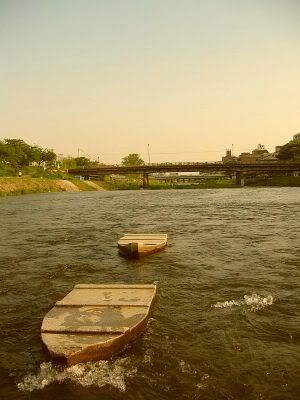The
Inari-shrine, one of the most popular and prosperous shrines in Japan, is closely related to the
kitsune (fox) tradition. According to the japanese folklore, these white foxes, the divine messenger and in service of the
Inari god, are different from the bewitchery or mischief of other foxes which are commonly called
nogitsune or wild foxes.

According to the legend,
Huli Jing, the Chinese foxes are earnest scholars, dedicated rakes, devoted lovers, seductresses
par excellence, tricksters, poltergeists, drinking companions and karmic avengers. Fox spirits arrived in Japan in the late 7th century. In the voyage across the ocean, some lost a few of the mentioned functions and the Japanese foxes did what their Chinese sisters failed to do. They were accepted as part of the official religion.

The
Inari-shrine became first associated with
kitsune, when a fox couple sought shelter in the shrine. They and their five children, were given sanctuary and protection by
Inari god, in exchange for their servitude.

Each swore ten oaths to
Inari, and were given positions in the shrine. Since then, descendants have served the god faithfully. The
kitsune protects those who work and live near the shrine, and aid those who come to them for help - protect them against the malevolent foxes and their bad omens. For example, trickster
nogitsune(s) employ their magical powers to play tricks on people; targeting overly-proud
samurai, greedy merchants, and boastful commoners, while the more cruel foxes tend to abuse poor tradesmen and farmers or even Buddhist monks. Sometimes the
nogitsune is assigned the role of seductress - these love stories usually involve a young human male and a
kitsune who takes the form of a woman.

Generally, according to the book '
Kitsune', there are listed thirteen different types of Japanese foxes. The named clans, Celestial and Wild, are mostly associated with the
kitsune that follow
Inari, and those that don't (the bad ones).

According to mythological beliefs, each year of spring, the god descends from the mountain to the rice fields and resides there during the subsequent agricultural season. Following the fall harvest, the deity would return once again to its winter home in the mountains. And all this took place at the same time that foxes appeared each season. As such, the fox naturally became known as the messenger of
Inari.

Rice and rice cultivation are an important part of Japanese culture. In early June, when rice farmers start planting, in order to pray for a good harvest, a 'rice-planting' ceremony (
ta-ue matsuri) is usually conducted in the shrine. Various offerings were made to the
Inari god. Chantings were performed by the head priest.

Selected women dressed in ancient costumes to perform a Shinto ritual dance accompanied by an orchestra of flute. To keep the god happy, only virgin girls can dance (as I have heard).

Prior to sowing, the field workers and female planters are first purified by the priest.

As seen in the pictures, men and women plant rice seedlings the old fashioned way in the sacred field (inside the shrine compound).

Farmers are afraid of epidemics and famine caused by insects that do harm to the rice plant. The
ta-ue matsuri has become the most important ceremony among the many rituals for agriculture.

According to several polls, it was reported that there are more than 30000 shrines in Japan dedicated to the
Inari god.

And the legend says, 'It is difficult to have
Inari without the fox and the fox without the
Inari'.


















































